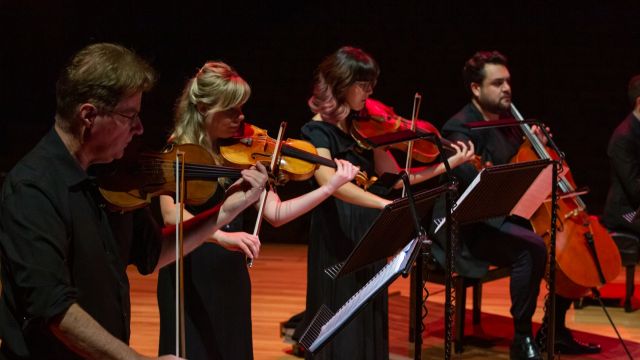Maps and Journeys: Navigating by the Sky
It’s easy to hear why the Southern Cross Soloists are considered one of Australia’s leading chamber orchestras. Maps and Journeys represents yet another show in which the group both enlightens and entertains with great technique and passion.
This performance took the crowd on a journey through a program of music and oratory themed around the rich wayfinding traditions of our first nations people, compared with the European navigational techniques. Both cultures find common ground in the use of stars and constellations in finding our ways to our destinations.
The show’s artistic director, Tania Frazer, said they were particularly inspired by Ginan. That’s the official name, given in 2017, to the smallest star in the southern cross. The name comes from the thousands-of-years-old, traditional name of the star by the Wardaman people of the Northern Territory. Composers have a long history of being inspired by celestial bodies, travel and maritime adventures, so Tania and the ensemble were spoiled for choice when it came to selecting which pieces to play.
Musician and radio host Lucas Burns gave a warm welcome to the show, introducing us to the themes of the performance and speaking on the significance of stars and navigation. He then brought to the stage the Southern Cross Soloists to perform a lively rendition of Vivaldi’s La Tempesta Di Mare (The Storm of the Sea). The rapid pace made guest flautist Jonathan Henderson work particularly hard at breath control and fast fingering. You almost expected him to collapse in an exhausted heap at the end of the bright, rollicking number. It was also an absolute delight to hear Alex Raineri on the Harpsichord for this piece. You could almost imagine yourself reclining in 1720s splendour, being entertained by these chamber musicians.
 Between numbers, guest speaker and prize-winning yachtsman Trevor Hill joined Lucas on stage to talk about the history of maritime navigation. It was fascinating to learn about how much and yet how little has changed since the end of the 13th Century.
Between numbers, guest speaker and prize-winning yachtsman Trevor Hill joined Lucas on stage to talk about the history of maritime navigation. It was fascinating to learn about how much and yet how little has changed since the end of the 13th Century.
Our musical entertainers then returned to present a languidly paced Adagio of Spartacus and Phrygia from Spartacus by Adam Khachaturian. The piece moved through relaxing waves of melodious strings and woodwind, after which the oboe and upper strings had a romantic dalliance, with countermelodies provided by cello and flute. Once you were lulled into a dream state by these swaying, romantic themes, the climax started to build. The peak shook you back into the real world to enjoy the melody once more before it slowly faded away, like a boat sailing over the horizon.
While our First Nations astronomy expert Kerry Neill wasn’t able to attend this concert, Lucas Burns did his best to convey the significance and history of astronomy and navigation. This served as a great introduction to Peter Sculthrope’s String Quartet No 12 from Ubirr (Earth Cry).
This dramatic and moody work had staging to match, with Chris Williams entering from the top stairway, playing didgeridoo as he descended into the stage space. This piece sounded like a collision of European pioneering and indigenous culture. The didgeridoo sounds represented the earth itself, crying for our love and caring attention, making for an emotionally moving work.
The Southern Cross Soloists’ rendition of Debussy’s La Mer L. 109 felt like you were drifting on the unpredictable ocean. Calm waters gave way to rising waves and adventures ahead represented by dancing woodwind. It was wonderful and somehow strangely relaxing (even in the exciting, climactic moments) to hear the excitement and changeability of sailing the sea represented in musical form; it was such delicious fruit for the imagination.
Arguably one of the biggest treats of the performance, composer John Rotar was present to introduce his work, Ginan: Songs of Knowledge. Written in collaboration with didgeridoo virtuoso, Chris Williams, the piece was inspired by the fifth brightest star in the Southern Cross and its meaning to the Wardaman culture, in which it represents a red dilly-bag filled with special songs and knowledge. This was the debut performance of the work and the audience were delighted and thrilled to hear it.
All musicians were absolutely excellent as you would expect from a show of this calibre. Lighting perfectly suited the mood of each piece and the reverse staging made for a wonderfully intimate experience. This was a lovely way to spend a Sunday afternoon.
Kiesten McCauley
Photographer: Stephen Henry
Subscribe to our E-Newsletter, buy our latest print edition or find a Performing Arts book at Book Nook.

